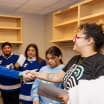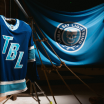Inside a case on the floor of the Tampa Bay Lightning bench -- underneath the bench itself where the players wait for their next shift and at the feet of the coaching staff standing behind them -- a video monitor displays an overhead shot of center ice with eight smaller camera feeds of different rink angles stacked to the right in two columns of four.
Watching a game on TV, when the Lightning get scored on, the camera occasionally pans to the bench area where you might notice the coaches looking down at their shoes.
They're not hanging their heads in shame or defiantly refusing to watch the opposition celebrate.
That video monitor is replaying the scoring sequence from the hawkeye feed being controlled in the back recesses of the locker room by Lightning video coach Brian Garlock, who scrolls through the various feeds, trying to find one that might cast doubt on the legitimacy of the goal.
The team behind the team: Lightning video coaches
Despite being behind the scenes on game days, video coaches Brian Garlock and Nigel Kirwan are a key extension of the Bolts' coaching staff
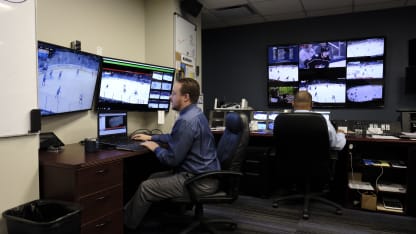
© SCOTT AUDETTE
Was the play offside? Could a high-stick have been used to put the puck into the back of the net?
"You can toggle through all these different camera angles, the bottom four, the blue lines, overheads and the two truck feeds," Garlock says. "This is cool software. With just the click of a button you can change it. You can zoom in on these and I'll move these around and stuff. You can split screen it, so that's synced up by time."
When a goal occurs, the coaching staff has about 30 to 40 seconds to make the call whether to challenge. They can delay a bit. Call the ref over and tell him you need a few more seconds to decide. Or take your time throwing a line out on the ice. Anything to buy yourself a few extra seconds.
"Usually for entries that don't lead directly to a goal, you get that whole possession time to be able to look at it," Garlock said. "So a lot of times, if there's an offside challenge, by the time that puck goes into the net the bench is already aware that the whole thing is offside and if it goes in we're going to challenge it."

© SCOTT AUDETTE
That happened Saturday in Tampa Bay's 3-1 home win over the New York Islanders. Mathew Barzal thought he'd netted the game's opening goal late in the first period when he roofed a backhander from a severe angle along the goal line.
But a replay showed he was well offside, Barzal a couple strides into the zone before the puck crossed the blue line. The Lightning coaching staff initiated a challenge, and after a fairly quick review by the officials, the goal came off the board.
"We don't challenge unless we are 100 percent sure it should be challenged," said Lightning video coach Nigel Kirwan, an original member of the Lightning organization. "Doesn't mean we're right, but only if we feel it should be challenged 100 percent. If it's iffy, we don't challenge. If we're unsure, we don't challenge. We'll say, 'Coop we're not sure. We think this but we can't tell. Your call,' on those grey area ones."
The coaches all have earpieces they can communicate with the video staff and vice versa.
"And I can send predetermined messages on (the hawkeye feed) too, like 'Good goal,'" Garlock says, showing how the message will pop up on the bench monitor. The messaging system is a fail safe in case the coaches aren't able to communicate through the microphones because of background noise, a common problem at home when the Lightning score because of the roar of the crowd and the Tesla coils distorting the audio for a few seconds
The coaching staff is dependent on the Fox Sports Sun video production truck located in the player parking lot next to AMALIE Arena to provide the camera angles that might show an offensive zone entry that led to a goal was offside or a high-stick was used to play a puck that eventually ended up in the back of the net. And sometimes the truck might not know what the coaches are thinking about challenging.
Kirwan recalls a time a couple of years ago, back before incorrectly challenging an offside led to a penalty, when, instinctively the coaches knew a play was offside and should be challenged. But the video feed from the truck hadn't provided a clear replay of the possible infraction by the time officials needed a yes or no on challenging from the staff.
"And then after we challenge, the truck realized we were challenging the offside, started playing more replay and we saw it clearly at another angle after we challenged that showed it wasn't offside, that we were wrong," Kirwan said. "But we didn't get that angle until after we challenged because the truck doesn't know what's going on because there's not communication between the two. So that's what people don't understand that we depend on the replays the truck shows us. And if they don't show it to us in time, we can't challenge it."
\\*
During the first period of a home game earlier this season, I get a first-hand look inside the assistant coaches' room while Kirwan and Garlock operate.
Step through the frosted glass double doors emblazoned with the Tampa Bay Lightning logo that signal the entrance to the Lightning locker room, take a right at the first junction and then an immediate left. The second door on the left is the assistant coaches' bunker with desk space for each assistant, a corner set up with all of the equipment for the video coaches, a table in the middle that doubles as a dry erase board with the outline of a hockey rink, a toilet and a shower.
There's a reason for those last two. The coaches spend an inordinate amount of time in this room.
Kirwan sits in front of a large screen TV showing the main Lightning feed while various other monitors display different angles of the game as well as out of town games. Garlock's got two TVs in front of him, the main feed on his left and another screen with eight different camera angles on the right.
Before I entered the room to begin reporting for this story, I erroneously thought the video coaches' main job during a game was to watch each play intently and apprise the coaches on the bench when a challenge should be made.
"Oh no, we're never looking for things to challenge," Kirwan explains. "We're just ready to challenge in case something happens."
So then, what do you do?
"Number one, to manage information for the coaching staff and the team and making sure that we have everything," Kirwan answers.
What does that mean?
When Kirwan says everything, he means, well, everything.
Any play that can happen during a hockey game - D-zone coverage, power-play zone, power-play breakout, injuries, hits, shots, chances for, chances against, fights, regroups, etc. - get marked by the video coaches. While play unfolds on the ice, the video coaches are furiously clipping the action in real time with the press of a button on their elaborate computer setup.
That way, when assistant coach Jeff Halpern, for example, wants to see all of the power-play zone entries from the Bolts' first power play of a game, he can pull it up on an iPad the coaches use on the bench from the clips the video coaches have marked. Or he can recall the video during intermission to diagnose what went right and what went wrong to correct for power plays later in the game.
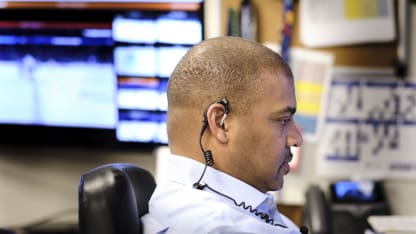
© SCOTT AUDETTE
"Coop may come in and say, 'I want to see chances against,' Kirwan explains. "Frantz needs to see everything that affects the goalies. So, between the two (video coaches), we make sure all that information is marked and indicated and ready to go so the coaches, well the players too, they can use that as much as they can."
The video coaches make sure every coach and player have all of the information they need, every video clip and statistic available, so they can make in-game adjustments that, hopefully, add up to another Lightning win.
"The computer has the ability to break that information up into its proper components and label it and also it's pre time coded so I can tell the computer when I hit this button, I want one second before and I want 15 seconds afterwards or in the case of a power play or a D-zone coverage or O-zone, you don't know how long before it's going to end," Kirwan said. "I know a regroup we're going to want to see the three or four seconds before the regroup and it shouldn't last about six, seven seconds, that's plenty of time. For that it's just a one-button thing, you hit it one time and it gives me 10-second blocks. Offensive zone, D zone, power play zone, PK zone, you don't know how long those are going to last so those are like interval buttons where we hit it once and then we have to hit it again to stop it there. It's really just time codes. The computer records all the video and it assigns a time code to every one-third of a second. And then we hit the buttons it's just recording all the time codes and playing back all those time codes based on what we tell the computer we want."
Think how quickly plays flows in the average NHL game. Now think how fast the mind and fingers must work in concert to mark every possible action on the ice.
"I feel like we play the piano, our fingers are constantly moving," Kirwan joked.
\\*
Inside the coaches' room during the game, Rick Peckham's play by play booms from a speaker in the ceiling, narrating the action as it unfolds on the screens in front of Kirwan and Garlock. The crowd noise is muted but present inside their cave. Krystof plays "Tequila" on the pipe organ, the fans shouting the song title when he gets to the payoff.
Kirwan and Garlock are banging away on their keys too.
"Nigel and I are both capturing. I'm capturing this camera that's up in the press box, that's this feed," Garlock explains, pointing to one of the videos on his screen. "And then Nigel is capturing this feed. So, he's live tagging everything: face-offs, forechecks, D-zones, O-zones, scoring chances. There's probably, I don't know, how many marks do you have Nigel, 30, 40, 50?"
"I'm not even sure," Kirwan answers.
"It's a ton," Garlock continues. "And then you can overlay all the NHL stats over that. Everything's got a place and gets categorized that way. I'm only marking one category, one thing and it's just part of our internal analytics."
"And then after the period, Nigel will stack these two up, so if I'm looking at a clip," Garlock pauses mid-sentence while eyeing the action on the screen. "That's in the net."
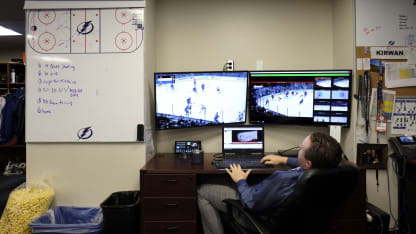
© SCOTT AUDETTE
Peckham in the background: Paquette takes out Tierney, walks away with the puck. He's pummeled on the near side on that collision with Goloubef. Centered in front, Paquette shoots, SCORES!!!!!!
"Right out of the pre-scout, Burnsie!" Garlock shouts.
"Is Hogberg Swedish?" Kirwan asks about the Ottawa goalie Marcus Hogberg as he and Garlock review the Lightning goal
"I think so," Garlock replies.
"Got a zulu, zulu, zulu," Garlock says into his microphone that goes into the earpiece of the Lightning coaches on the bench. I can only assume 'zulu' means good goal. I don't ask because don't want to break the laser-like focus of the two video coaches while they work.
Before the end of the period, I clear out of the room so the coaches can have it to themselves during intermission. But before leaving, I ask Kirwan how much they have to do once the game is over.
"There's a lot," he says. "We import NHL stats and lay that on top of the video. The computer company that we use they take the date the NHL captures, put it in a file and I can lay that on top of the video and sync it up. It's an additional layer of data that we use. So now afterwards, I can tell the computer, spit out all of Kucherov's shifts, and it knows based on the time codes that the NHL captures that I've now laid on top of the video, it'll find all those shifts for me and print them out. I can upload those to the server and send those to the players right after the game via the cloud. We stack the videos too. We take the program feed and the coaches cam feed and we lay those on top of each other so that when the game's over, a coach can be watching the period from one angle, click a button and it'll flip another angle we've captured."
And that's just for one game. The NHL schedule is 82 games long with back-to-backs and long road trips and whatever else might pop up to continually keep the coaches occupied.
Absolutely. It never stops," Kirwan said. "There's always another game coming."

